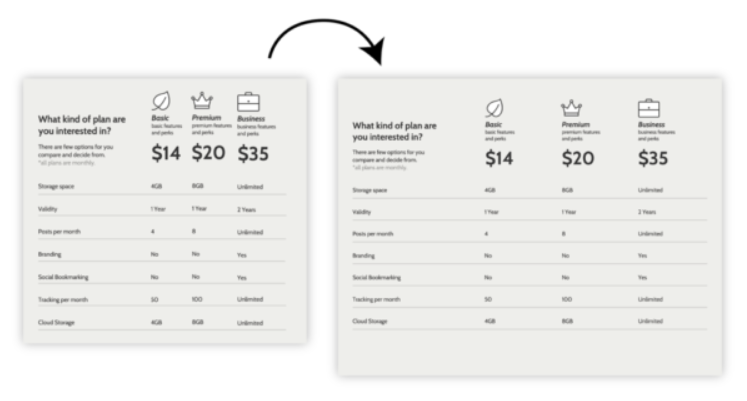
According to Content Marketing Institute, visuals are essential to creating content that will help your business stand out and draw in an audience. Not only does imagery help make text-centric content more readable, digestible, and memorable, but it can be used to craft compelling messages that speak volumes without using a single word – just ask anyone who has posted a photo on Instagram, tweeted a meme to express their feelings, or created an Instagram video to share a memorable moment with friends.
Considering how rapidly visual trends come and go and how often new creative platforms and capabilities emerge, it’s always worth taking a fresh look at ways to let your brand’s photos, videos, and graphics do the talking.
Align your visual story with your content marketing strategy
Like any content marketing format, you should have a compelling rationale for communicating with your audience through visual storytelling, as well as a clear plan for turning views into meaningful marketing results. A thoughtfully focused strategy can mean the difference between creating a one-note viral joke and becoming a master of the visual content medium.
Before you ask your content creators to sketch their ideas, make sure you know the answers to these questions:
- What are we trying to accomplish with our visual content?
- Who are our audience members? What kinds of content experiences are they interested in?
- What problems does our organization solve?
- How can we create a consistent brand voice that communicates our value?
- What is our clearly defined vision of who we are and what makes us unique? How can we communicate those messages in a compelling way?
- What metrics will we use to measure success? For which terms should this image appear in search engine results?
Know the rules of good design
While the wealth of DIY design tools available online and on social media can give almost anyone the ability to create visual content, they don’t necessarily provide the know-how to do it well.
By following the few basic design principles outlined by Venngage’s Midori Nediger even graphically challenged marketers can learn to craft imagery that both draws the eye and drives the conversation forward:
- Give your imagery room to breathe: Failing to leave enough white space between your visuals can make a page seem cluttered and hard to follow, causing your content to become more of a distraction than an attraction for your audience. To give your core elements some breathing room, Midori recommends removing images that don’t add to the visual conversation and expanding the space between unrelated elements to clarify page structure.

- Don’t get color-blindsided: Your image assets should stay true to your branding guidelines, including your business’s color preferences. But don’t get so caught up in executing this priority that you overlook whether those colors will work well together online. Pick one color to use as a base, then find compatible complementary colors with an online color-wheel tool.
- Speed up your page loads: Visual experiences are slowed down when images aren’t properly sized and compressed. That can send potential viewers straight to the back button in search of more accessible options. Use tools (like this simple one from Google) to check how quickly images load to determine whether they might need to be adjusted for consumption on different platforms and devices, including mobile.
- Typography decisions matter: Pro designers are known to have strong opinions about font styles and spacing choices for good reason. Not only is choosing the proper font size, weight, and spacing critical to readability, poor typography decisions can also conflict with crafting messages that are understandable and memorable.
Don’t be afraid to get emotional
Some of the most memorable visual experiences are those that found a way to tap into the power of emotion.
Personal stories can also up the emotional empathy quotient of your visual content. One way to capitalize on this is by keeping a lookout on social media for great customer stories that your brand can bring to life through powerful visuals. For example, Southwest Airlines turned a customer-posted Facebook photo into the memorable spot Hudson’s Big Day, a once-in-a-lifetime experience that the company captured on video:
Avoid generic stock images
Using professional photographers and high-powered camera equipment is one way to approach quality image creation, as their talents and capabilities can often help your brand tell richer and more compelling stories. However, if cutting-edge equipment (and the talent to operate it) is out of your price range, using a stock-image service can be a viable alternative – but find ways to put your branded spin on the images.
Repurpose information and insights as visuals
Content marketers can adapt their most popular written or audio content into compelling visuals – including data-driven formats like infographics, charts, or checklists. Not only is it an excellent way to draw fresh attention to your evergreen content, but it also helps make your brand’s insights more digestible, memorable, and shareable.
For example, Venngage surveyed design experts on the latest visual trends they’ve noticed and turned the results into an infographic to inspire its audience to be forward-thinking with their designs:

Use your fans’ content
Consumers love to snap their own pictures and share selfie videos with their friends. Instead of interrupting their experience with product shots and promotional pitches, why not include their creative work in your content marketing?
Stay on brand
Whether or not you’re getting fans involved in your imagery, take steps to maintain your brand’s visual identity – including how your corporate colors and logos are used. Ideally, all your content assets should feature a consistent design motif – one that viewers can instantly recognize and identify with your brand, no matter where the content appears or who creates it.
You also need to pay attention to the way your target distribution platform publishes those images because the specs and size requirements might not be the same across the board. If you aren’t paying close attention, the hard work put into crafting the perfect image to share can get mixed up or mangled in a way that can mask your brand’s value.
Don’t forget to add your logo to your original images and tag them with relevant keywords, categories, hashtags, and metadata. This helps your fans find your content — even when it gets shared in unfamiliar contexts.
Tailor visuals to the delivery platform
In addition to appearance considerations, you need to consider how well those visuals fit the conversational context and audience preferences of each sharing environment. Of course, with the right insights, your visuals can find an audience anywhere – even in places you wouldn’t expect to be a good fit.
Find the right tools to help you get the job done
The above practices should make it easier to understand what quality visual content creation entails. However, producing that content on an ongoing basis can still pose a challenge for many businesses.
Though there’s no substitute for the expertise and skill of a dedicated professional designer, plenty of robust visual content apps and tools can help you manage the basics, like editing photos, adding captions, and reformatting images for social media – including those you can find on your smartphone’s camera app.
You can also work with more specialized tools when you are ready to branch out in unique visual directions – like the WordSwag app that social media strategist Rachel Pedersen uses to turn her ideas, quotes, and content into attractive graphics that can be shared on Facebook, Instagram, and anywhere. BreadandBeyond founder Andre Oentoro also recommends several apps he uses to spice up his visuals for use on Instagram.






